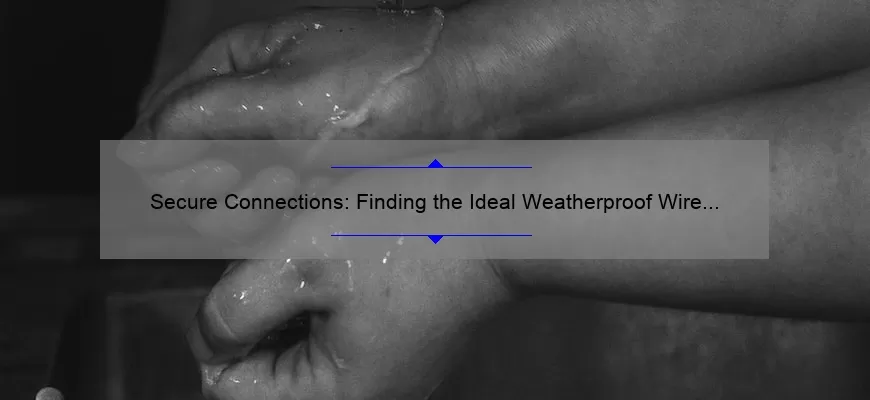- Step-by-Step Guide to Using Ideal Weatherproof Wire Nuts for Secured Electrical Connections
- Common FAQs About Ideal Weatherproof Wire Nuts Answered
- Top 5 Facts To Know Before Investing in the Best Ideal Weatherproof Wire Nuts
- How Do Ideal Weatherproof Wire Nuts Protect Your Home from Extreme Weather Conditions?
- Understanding the Science Behind Ideal Weatherproof Wire Nuts and Their Applications
- Tips and Tricks for Proper Installation of Ideal Weatherproof Wire Nuts for Maximum Efficiency and Safety
Step-by-Step Guide to Using Ideal Weatherproof Wire Nuts for Secured Electrical Connections
As an electrician or handyman, you must have come across the problem of loose or exposed wires in electrical connections. The Ideal Weatherproof Wire Nuts have revolutionized secure wiring connections by providing a water-tight and air-tight seal with a superior grip. In this step-by-step guide, we will discuss how to use these wire nuts for efficient and long-lasting electrical connections.
Step 1: Gather Required Materials
Gathering materials is the first necessary step when working on any project. Here are some essential items required when using Ideal Weatherproof Wire Nuts:
– Ideal Weatherproof Wire Nuts
– Electrical tape
– Wire strippers/cutters
– Gloves (optional)
Step 2: Selecting the Right Size Wire Nut
The Ideal Weatherproof Wire Nuts come in different sizes depending on your wiring requirements. It’s crucial to select the right size wire nut, which fits securely over both wires being connected.
Step 3: Strip the Wires
It’s essential to strip off approximately half-inch of insulation from each wire being connected. Ensure that you don’t cut into the copper strands beneath insulation to avoid weakening them.
Step 4: Twist Wires Together
Twist together stranded wires by holding one end of each wire in either hand and wrapping them around each other clockwise or counter-clockwise direction, preferably clockwise direction, until they bind together as tightly as possible.
Note:
Ensure that there aren’t any loose strands of wire sticking out; this could compromise your connection’s safety and lead to potential hazards like electrical sparks, short circuits, etcetera.
Step 5: Securely Insert Wires into Wire Nut Hole
Insert both twisted ends of stripped wires’ combination at an equal depth inside an appropriately sized Ideal Weatherproof nut hole. Tighten it clockwise direction alternatively covering all conductor surfaces available space while connecting it firmly and locking their grips on inter-connected wires underneath insulation hole.. You must conduct a wire tug test to check the strength of your connection.
Step 6: Wrap Electrical Tape over Wire Nut for Extra Protection
Use electrical tape to wrap around the wire nut and wires connected for additional protection. Ensure that you include exposed parts of the twisted ends because electrical tape gives an extra layer of insulation to your connections, making them more secure and resistant to moisture that could affect electric circuits.
That’s it! Follow these six easy steps, and you have successful long-lasting electrical connections using Ideal Weatherproof Wire Nuts (Water-Tight & Air-Tight Seal). With this guide in hand, de-cluttering electrical wiring becomes a stress-free endeavour as you rest assured about the safety and quality connection with those wire nuts.
Common FAQs About Ideal Weatherproof Wire Nuts Answered
Weatherproof wire nuts are a crucial part of any outdoor electrical installation. They provide the necessary protection against moisture, dust, and other environmental factors that can damage electrical connections. These wire nuts come in different sizes, shapes, and colors to suit various applications.
However, many homeowners and professionals alike have questions about weatherproof wire nuts – how they work, where to use them, and which ones to choose. This blog post aims to address some of the most common FAQs about ideal weatherproof wire nuts.
What is a Weatherproof Wire Nut?
A weatherproof wire nut is an electrical connector designed to protect electrical connections from exposure to harsh environmental elements like moisture or humidity. These connectors typically feature a waterproof sealant that keeps the connection secure even in wet conditions. The sealant also inhibits corrosion of metallic parts and protects the wires from damage due to exposure.
Where Can You Use Weatherproof Wire Nuts?
Weatherproof wire nuts are suitable for all kinds of outdoor use where wires need to be connected. Some common applications include landscape lighting, pool wiring, irrigation systems, garden fountains or water features, exterior outlets or lighting systems.
How Do You Choose the Right Size?
Choosing the correct size of a weatherproof wire nut is critical for ensuring an optimal connection between two wires. To determine the appropriate size needed for your project measure your wires’ gauge thickness and count how many wires need connecting together as one unit with weather proofing.
How Many Wires Can Be Used With A Weather Proof Wire Nut?
The number of wires you can connect using a single weather-proofed nut depends on its size; connecting more than recommended could lead it breaking due strain at where two connect into one. It’s suggestable not exceeding manufacturer recommendations on packaging nor device specifications during installations; this ensures safety requirements are guaranteed.
Do I Need Special Tools For Installation?
No special tools exist for installing these products although some pliers may make tightening easier; however, be sure to examine the nuts for a proper fit and engagement on the wires. Always use caution when tightening because an overtightened nut can strip threads or even deform the protected cable making it more vulnerable to environmental damage.
Which is Better: Twist-on nuts or Push-In Connectors?
Twist-on wire nuts offer a stronger and more reliable connection especially given the harsh outdoor environments they may face; push-in connectors are easier to install and only work well with specific size requirements. If you’re unsure about which connector type is best suited for your installation, consult the manufacturer’s recommendations.
Conclusion
Weatherproof wire nuts provide essential protection for electrical connections that are exposed to harsh outdoor conditions. They offer a simple but effective solution through their design while remaining affordable in pricing in most cases Choose wisely following all recommended documentation suits particularly used by reputable manufacturers whenever handling this type of protective equipment. Take time researching before purchasing any weatherproofing product due to variability in quality and types marketed toward various applications.
Top 5 Facts To Know Before Investing in the Best Ideal Weatherproof Wire Nuts
Investing in the best weatherproof wire nuts can make a significant difference in ensuring that your electrical connections remain secure and protected against harsh weather conditions. These small yet essential components are designed to safeguard electrical connections from moisture, dust, and other environmental elements that could cause damage or create electrical hazards. However, before you invest your hard-earned money into buying the ideal weatherproof wire nuts, here are the top 5 facts you need to know to make an informed decision.
1. Understand The Different Types of Weatherproof Wire Nuts
Weatherproof wire nuts come in different types and sizes depending on their intended application. For example, they could be used for outdoor lighting fixtures, underground splices, or marine applications. Therefore, it is crucial to understand which type of weatherproof wire nut suits your specific needs. A few popular types include twist-on connectors, push-in connectors, and crimp connectors.
2. Choose The Right Material
The material used to manufacture weatherproof wire nuts determines how well they will withstand harsh weather conditions. The most common materials used include ceramic blends or rubber-based compounds combined with silicone grease or corrosion inhibitors that resist rust formation.
3. Know How To Choose The Right Size
Choosing the right size for your weatherproof wire nut is essential to ensure it fits snugly over the wires you plan on connecting securely. Investing in the wrong size can lead to loose connections and even pose a hazard due to current arcing caused by physical strain.
4. Consider IP Ratings:
When looking for an ideal weatherproof wire nut, one of the features you want to consider is its IP rating (Ingress Protection Rating). This rating system helps determine how well water-resistant/ waterproof products are against dust penetration & solids ingress (1st Numeral) along with resistance against liquid ingress & surface exposure from multiple angles(2nd Numeral). The higher the number assigned to an item’s IP rating – e.g., IP68 – the more waterproof they are.
5. Talk to A Professional Electrician
The best way to ensure you purchase high-quality weatherproof wire nuts is by seeking professional advice from an experienced electrician. Consulting with a professional ensures you get expert recommendations, and the installation process meets electrical codes while guaranteeing that your investment is appropriately protected.
In conclusion, investing in a set of ideal weatherproof wire nuts can save you unnecessary headaches caused by damages or hazards resulting from poor quality connectors during harsh weather conditions. Understanding the different types, materials, sizes, product ratings, and consulting with professionals helps make sure you have made an educated decision before purchasing or installing your new equipment.
How Do Ideal Weatherproof Wire Nuts Protect Your Home from Extreme Weather Conditions?
Weatherproof wire nuts are an essential component of your home’s electrical system that protects your property from the elements. These connectors help keep your electrical connections secure and safe during extreme weather conditions, such as heavy rain, snow, or high winds.
When it comes to weatherproof wire nuts, you want to find a product that can stand up to harsh environments while being easy to use. The ideal weatherproof wire nut is waterproof and can withstand temperatures ranging from -40°F to 221°F so that it can perform well in any weather condition.
Here are some reasons why these wire nuts are so important for protecting homes from extreme weather conditions:
1) Waterproof: Weatherproof wire nuts are made of materials specifically designed for outdoor applications. They come with a silicone-based sealant, which provides a watertight connection between two wires. This ensures that water does not seep into the connections leading to short circuits or electrocutions.
2) Durable Housing: The tough housing around our preferred brand, like Ideal weatherproof wire nuts, provides excellent protection against corrosive substances like saltwater or chemicals present outside. It also protects the wires and other components from physical damage due to harsh weather conditions.
3) Easy Connections: The ideal weatherproof connectors have strip guide markings indicating the appropriate length needed for the wires before connecting them. Connectors should quickly twist on tightly without any additional tools while maintaining connectivity even in extreme environmental factors.
4) Safe & Secure Connections: Exposed wiring due to broken seals or worn out insulation leads lead to short circuits- gaining moisture results in electrical conduction throughout another route and becomes extremely dangerous quickly. With waterproof connectors like Ideal’s Wire Nuts- homeowners do not need worries about accidental shorts occurring with their outdoor/electrical equipment under severe climatic changes.
In conclusion, investing in quality Weatherproof Wire Nuts goes beyond the aesthetic values of a professionally done job; it promotes safety first by ensuring the electrical connections remain dry and can withhold in extreme weather conditions. These wire nuts are a wise choice to secure your lightings, fountains, yard equipment or any outdoor electronics that require an electrical connection for longevity and reliable power. So whether you experience a hurricane, cyclone or just a heavy downpour; Ideal’s Weatherproof Wire Nuts will have your essential electrical connections protected from the storm.
Understanding the Science Behind Ideal Weatherproof Wire Nuts and Their Applications
Weatherproof wire nuts are an essential component when it comes to outdoor electrical connections, as they provide a protective seal against moisture and other weather elements. However, not all wire nuts are created equal, and the science behind what makes an ideal weatherproof wire nut is important to know.
At their most basic level, wire nuts work by connecting two or more wires together using a twist-on design. They offer a secure connection that prevents any loose wires from coming into contact with one another and causing a short circuit. With weatherproof wire nuts, there is an added layer of protection. A sealing material inside the connector ensures that the wires are protected from moisture ingress.
So what sets ideal weatherproof wire nuts apart? The answer lies in a few specific factors.
Firstly, materials matter. High-quality materials such as nylon provide superior durability and resistance to extreme temperatures (both hot and cold). It’s also important to consider the quality of the sealing material used within the wire nut – is it moldable, self-healing or malleable enough to form around each individual wire?
Secondly, size plays a crucial factor in selecting ideal weatherproof wire nuts for your application. Wire gauge size is critical in determining which type of wirenut will fit accordingly as it directly affects its efficacy – preventing conductor dislocation and keeping water out for longer periods of time.
Lastly – certification matters! You can’t just slap some waterproof sealant onto any old connector and call it “weatherproof”. Look for connectors certified under IP67/68 standards that undergo rigorous test protocols ensuring they remain watertight within varying conditions. This ensures manufacturers place emphasis on maintaining high-quality standards for products.
In addition to choosing the right type of weatherproof wire nut based on materials used, size of conductors being terminated and certain certifications proving their effectiveness; understanding your application’s surrounding environment with respect to temperature ranges (are they exposed to UV radiation?), mechanical stresses (vibrational or environmental impact), can ensure that you will select an ideal wire nut that can withstand even the toughest of conditions.
Overall, choosing the right weatherproof wire nut for your application is critical to ensuring a reliable outdoor electrical connection. By taking into account material quality, sizing and certification standards – understanding how to match those qualities with surrounding environment characteristics by utilizing these simple factors in selecting an ideal wirenut can help in ensuring long-lasting electrical connections!
Tips and Tricks for Proper Installation of Ideal Weatherproof Wire Nuts for Maximum Efficiency and Safety
As an electrician, safety should always be your top priority. One of the best ways to ensure the safety and efficiency of your electrical work is by properly installing wire nuts in weather-proof applications.
In this blog post, we will provide you with tips and tricks for proper installation of ideal weatherproof wire nuts. From understanding the different types of wire nuts available to learning how to install them correctly, this post will help you achieve maximum efficiency and safety in your next electrical project.
1. Understand the Different Types of Wire Nuts
There are many different types of wire nuts available on the market today. Some are designed for indoor use while others are specifically engineered for outdoor applications or even underwater installations.
When selecting a wire nut for a weatherproof application, it’s important to choose one that is specifically labeled as “weather-resistant” or “waterproof”. These types of wire nuts are typically made from materials like silicone rubber or thermoplastic elastomers, which provide superior protection against moisture and temperature fluctuations.
2. Properly Prep Your Wires
Before installing any wire nut, it’s important to prepare your wires properly. This means stripping off enough insulation so that there is enough exposed copper to make a secure connection inside the nut.
You should aim to strip off about 3/4 inch (19mm) of insulation from each wire end before twisting them together tightly using pliers. Make sure that both wires are aligned neatly so that they can fit easily into the wire nut without causing any cross-threading issues.
3. Choose the Right Size Nut
Choosing the right size nut is crucial when it comes to maximum efficiency and safety in your electrical projects. The most common sizes for standard residential wiring are #22-#14 AWG (American Wire Gauge) wires.
Make sure that you purchase a weatherproof conductor-sized plug compatible with stranded copper wires if you’re working with stranded cables; otherwise, go for standard conductor-sized plugs if you’re connecting solid copper wires.
4. Twist the Wire Nut Tightly
Once both ends are properly prepped and the wire nut is selected, twist it securely onto each wire end aligning them neatly with no cross-threading issues. The goal is to create a tight seal around the wires so that they do not come loose over time or cause electrical hazards due to poor connections.
If the wires are too thick or have irregular-shaped insulation, you may need to back off and re-strip for as much stripped wire length as needed but never more than necessary because lead exposure of even trace amounts can be harmful in many ways.
5. Test Connection
After installation of your weatherproof wire nuts, take time to check your connections by tugging or shaking them gently in opposite directions, ensuring there is no play between them. Any visible gaps can signal improper installation or compatibility and, thus could lead to serious safety hazards or an expensive damage down the line.
Weather-resistant Electrical work requires careful planning and execution regardless of its difficulty level. By following these simple tips on selecting, preparing, twisting and testing connections of ideal weatherproof wire nuts during installation ensures maximum efficiency which wouldn’t just save costs on maintenance overtime but would also ensure peace-of-mind safety for all involved parties after completing your electrical installations.



![Unlocking the Mystery of Black Gorilla Lug Nuts: A Story of Strength and Style [5 Essential Tips for Choosing the Best Lug Nuts]](https://baru-nuts.com/wp-content/uploads/2023/04/21-335x220.jpg)
![Rev Up Your Ride: The Ultimate Guide to Black Chrome Lug Nuts [Solve Your Wheel Woes with Expert Tips and Stats]](https://baru-nuts.com/wp-content/uploads/2023/04/22-335x220.webp)
![Binky Goes Nuts: A Tale of a Mischievous Pet and How to Keep Them Calm [Expert Tips and Stats]](https://baru-nuts.com/wp-content/uploads/2023/04/23-335x220.jpg)


